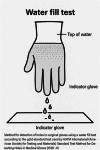Surgical glove perforation in caesarean section and its association with surgical site infections: a prospective cohort study
- PMID: 40796812
- PMCID: PMC12341099
- DOI: 10.1186/s12884-025-08002-3
Surgical glove perforation in caesarean section and its association with surgical site infections: a prospective cohort study
Abstract
Objective: Infectious complications at the surgical site complicates 1-4% of cesarean deliveries. Strict aseptic technique, hand hygiene and the use of sterile surgical gloves are essential to reduce the risk of surgical site contamination. Glove perforations are observed in almost 30% of all procedures and represent an underestimated potential risk factor for postoperative infections. The aim of this prospective study was to investigate glove perforation rates in cesarean deliveries and to analyze the impact of unrecognized glove perforations during surgery on surgical site infection rates after cesarean delivery.
Method: Surgical gloves from cesarean section were collected prospectively. All gloves were inspected for perforation holes. Cases in which surgical gloves had visible (macro) perforations were excluded from the study. Remaining gloves were examined using a water-fill test. Gloves with a positive water filling test were defined as the study group and negative gloves as the control group. Superficial Surgical Site Infections (SSI) were analyzed for the groups.
Results: A total of 1,779 pairs of used surgical gloves were collected and examined for perforations across 593 cesarean operations. Macro perforation were observed in 56 (9.4%) operations. The remaining 1,611 pairs of gloves underwent water-fill testing. Of these, 505 operations had completely intact gloves, while in 32 (5.4%) cases, micro-perforations were identified. SSI occurred in 18 women (3.3%): 7 in the perforation group (21.8%) and 11 in the control group (2.2%) (p < 0.001). In multivariable logistic regression analysis, glove micro-perforation was found to be a significant independent predictor of SSI (adjusted odds ratio: 12.705; 95% CI: 4.244-38.039; p < 0.001), even after adjusting for potential confounders including diabetes, obesity, emergency cesarean, operative duration, and intraoperative blood loss.
Conclusion: Our data show that glove perforation is unexpectedly common and underestimated in terms of unfavorable surgical outcomes. The rate of surgical site infections is increasing and we suggest that unrecognized glove perforation must be considered as a risk factor for surgical site infection after cesarean section.
Keywords: Cesarean Section; Surgical Site Infection; Surgical glove perforation.
© 2025. The Author(s).
Conflict of interest statement
Declarations. Ethics approval and consent to participate: All patients gave informed consent to be enrolled in this project and the study was approved by the local ethics committee of the institution (May 22, 2024; No. AEŞH-BADEK-2024-448) and was conducted in accordance with the Declaration of Helsinki. The data were anonymized and handled in compliance with ethical guidelines to ensure participant confidentiality. Consent for publication: Not applicable. This study does not contain any individual person’s data in any form (including any individual details, images, or videos) that would require consent for publication. Competing interests: The authors declare no competing interests.
Figures
Similar articles
-
Double gloving to reduce surgical cross-infection.Cochrane Database Syst Rev. 2006 Jul 19;2006(3):CD003087. doi: 10.1002/14651858.CD003087.pub2. Cochrane Database Syst Rev. 2006. PMID: 16855997 Free PMC article.
-
Gloves, extra gloves or special types of gloves for preventing percutaneous exposure injuries in healthcare personnel.Cochrane Database Syst Rev. 2014 Mar 7;2014(3):CD009573. doi: 10.1002/14651858.CD009573.pub2. Cochrane Database Syst Rev. 2014. PMID: 24610769 Free PMC article.
-
Double gloving to reduce surgical cross-infection.Cochrane Database Syst Rev. 2002;(3):CD003087. doi: 10.1002/14651858.CD003087. Cochrane Database Syst Rev. 2002. Update in: Cochrane Database Syst Rev. 2006 Jul 19;(3):CD003087. doi: 10.1002/14651858.CD003087.pub2. PMID: 12137673 Updated.
-
Is Your Surgical Helmet System Compromising the Sterile Field? A Systematic Review of Contamination Risks and Preventive Measures in Total Joint Arthroplasty.Clin Orthop Relat Res. 2025 Jun 1;483(6):972-990. doi: 10.1097/CORR.0000000000003383. Epub 2025 Feb 5. Clin Orthop Relat Res. 2025. PMID: 39915114
-
Prescription of Controlled Substances: Benefits and Risks.2025 Jul 6. In: StatPearls [Internet]. Treasure Island (FL): StatPearls Publishing; 2025 Jan–. 2025 Jul 6. In: StatPearls [Internet]. Treasure Island (FL): StatPearls Publishing; 2025 Jan–. PMID: 30726003 Free Books & Documents.
References
-
- Ilhan G, Verit Atmaca FF, Kaya A, Ergin AH, Gökmen Karasu AF, Turfan M. Risk factors and microbiology of wound infections following Cesarean delivery: experience of a single institution. J Infect Chemother. 2016;22(10):667–70. - PubMed
-
- Berríos-Torres SI, Umscheid CA, Bratzler DW, Leas B, Stone EC, Kelz RR, et al. Centers for disease control and prevention guideline for the prevention of surgical site infection, 2017. JAMA Surg. 2017;152(8):784–91. - PubMed
-
- Kirkland KB, Briggs JP, Trivette SL, Wilkinson WE, Sexton DJ. The impact of surgical-site infections in the 1990s: attributable mortality, excess length of hospitalization, and extra costs. Infect Control Hosp Epidemiol. 1999;20(11):725–30. - PubMed
-
- Widmer AF. Surgical hand hygiene: scrub or rub? J Hosp Infect. 2013;83(Suppl 1):S35–39. - PubMed
LinkOut - more resources
Full Text Sources



